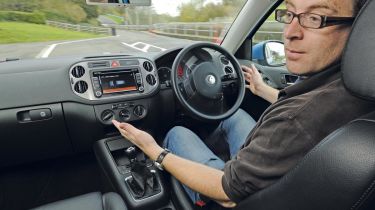Self-parking - Volkswagen
Nerve-wracking manoeuvres and low-speed scrapes could be relegated to history... at last!

Ask people what driving skill they would really like to master, and many would say it’s parking. So a car that can do it for you sounds like a dream come true.
But can motors really get you into a space more accurately and quickly? To find out, we lined up our long-term VW Tiguan, which is fitted with the manufacturer’s Park Assist.
Automated parking systems were pioneered by Lexus – we tested the technology in an LS460 in 2007 (Issue 957). Then, the time-consuming nature of the operation made the system hard to recommend. Unless you were truly terrible, it was simpler to do it yourself. This latest technology from VW is different. It operates only in parallel-parking situations and is considerably more straightforward to use.
Because there’s no need for an expensive reversing camera or sat-nav monitor, the option is a reasonable £475. You simply press the Park Assist button and drive slowly past your chosen space. If the parking spot is on the other side of the road, you merely indicate in the required direction and the system adjusts accordingly.
Using sensors mounted on the bumpers, the VW decides if the gap is big enough. A dash display shows an arrow in the direction it wants you to move for the ideal starting point.
It tells you when to stop and select reverse, and from this point on, you only operate the throttle and brake. The display shows that the automated steering is in operation, and the process begins. As the vehicle moves back, the steering wheel spins to fishtail the Volkswagen into the space in a single movement. From the driver’s seat the process is initially disconcerting, as the nose of the car gets very close to the vehicle in front. However, during all of our tests, the Tiguan parked neatly and cleanly in the gap.
If you press the accelerator too hard or touch the steering, the system shuts off. But you can brake, and the parking sensors clearly warn you when to bring the manoeuvre to an end. It took a mere 21 seconds for Park Assist to slot the car into the space – and we couldn’t beat this time, despite several attempts, or park as neatly.
However, Park Assist has its limitations. It works only in spaces big enough to snake into in one movement. Our picture (opposite) shows the size, which isn’t easy to find in busy urban areas. If the system calculates the spot is too small for the manoeuvre to be carried out in one movement, it won’t even attempt to do so. Yet by shunting the Tiguan back and forth, you can fit into even smaller gaps.
Plus, if you are letting the car park itself, you have to pass the space in order to reverse in, and there are rude motorists who will nip in while you’re positioning yourself! Low or protruding kerbs can also present a problem. And Park Assist needs points of reference – if there’s a completely empty row of potential spots it can’t park for you, as there’s nothing to bounce its sensors off. Even so, in the right situation, the ease with which Park Assist slots the vehicle into a space is highly impressive. Very few drivers could match its accuracy or speed.
VERDICT: Self-parking
* Technology: Volkswagen Park Assist
* Car tested: 2.0 TDI Tiguan SE 4Motion (£22,745)
* Also available on: Golf, Touran, Passat CC
* Price on tested car: £475
* Other manufacturers with similar technology: Lexus, Toyota, Honda, plus Ford in the US
* Hit or miss? HIT
Details
WHY: Parallel parking can be a nightmare. VW’s Park Assist is a simple and reasonably affordable solution. But does it work?






